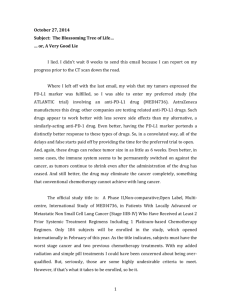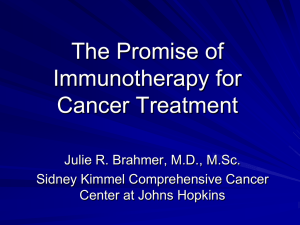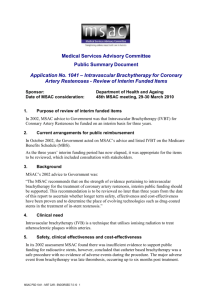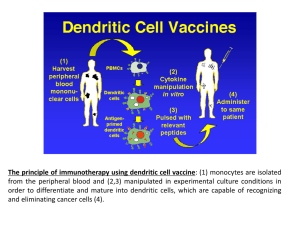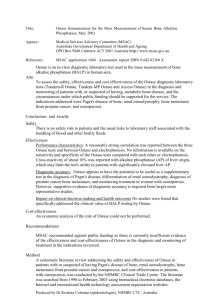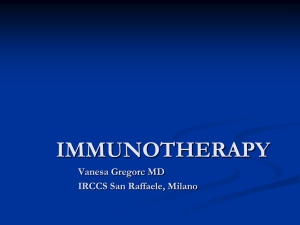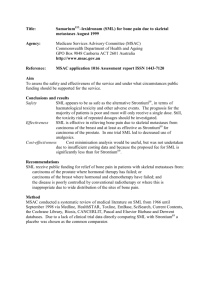Consultation Protocols - the Medical Services Advisory Committee
advertisement
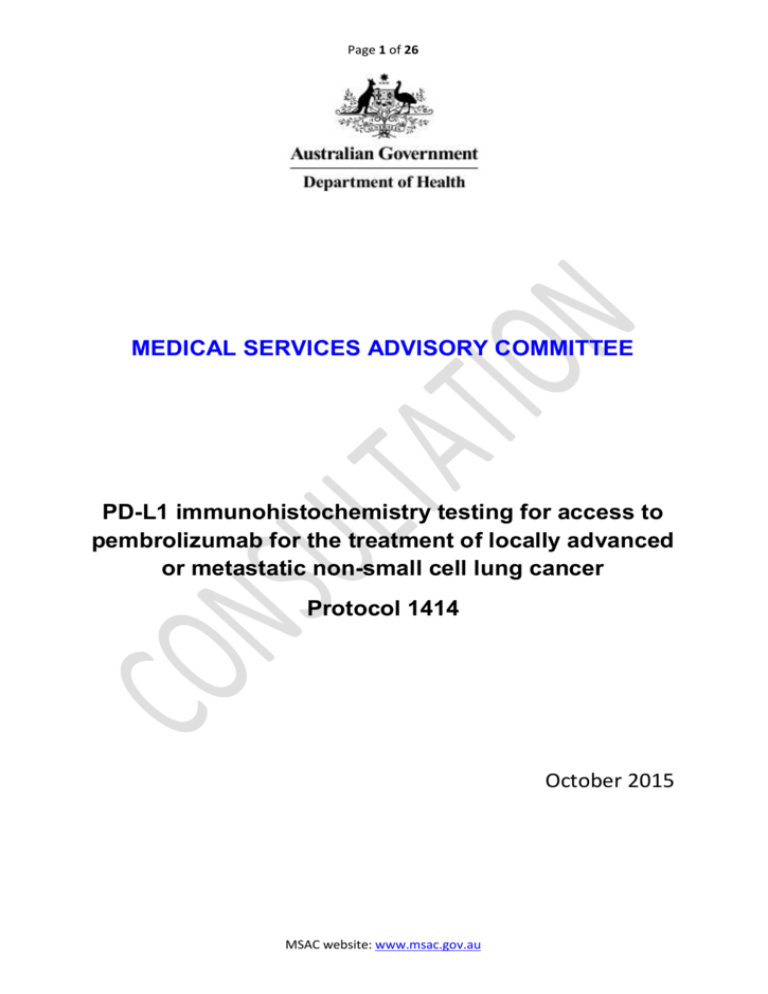
Page 1 of 26
MEDICAL SERVICES ADVISORY COMMITTEE
PD-L1 immunohistochemistry testing for access to
pembrolizumab for the treatment of locally advanced
or metastatic non-small cell lung cancer
Protocol 1414
October 2015
MSAC website: www.msac.gov.au
Page 2 of 26
Purpose of application
This application is requesting a Medicare Benefits Schedule (MBS) listing for testing of Programmed
Death 1 Ligand (PD-L1) expression in advanced non-small cell lung cancer (NSCLC). This listing is
required, should MSD decide to lodge an integrated co-dependent submission for use of the PD-L1
test to determine eligibility for pembrolizumab.
To provide context for the remainder of this application, the next two sections will outline the
proposed role of the PD-1 pathway in NSCLC and clinical trial data highlighting a potential predictive
role of PD-L1 expression in determining response to pembrolizumab in NSCLC.
A full of overview of these results are outlined in Garon et al 2015. The role of PD-L1 as a predictive
biomarker is summarised in Patel et al, 2015.
Population and medical condition eligible for the proposed medical
services
Non-small cell lung cancer
Lung cancer is the 5th most commonly diagnosed cancer, with over 10,000 patients diagnosed each
year, and a prevalence of around 94 people per 100,000.1 In 2014, lung cancer was the most
common cause of cancer death, accounting for 18.9% of all cancer deaths (8,630 deaths).2 Non-small
cell lung cancer (NSCLC) accounts for approximately 66% of all lung cancer cases3. Progress has been
made in the clinical management of early stage NSCLC. However, the prognosis for advanced disease
has not improved substantially. With an overall 5-year survival rate of 13-16%, the treatment of
NSCLC remains a high unmet medical need4.
Role of the Programmed Death-1 pathway as a therapeutic target in cancer
In recent years, it has become apparent that cancers are recognized by human immune system and
that under certain circumstances the immune system can obliterate tumours. Recently, the PD-1
pathway has emerged as a major immune checkpoint by which tumours suppress lymphocyte
function. This pathway consists of PD-1, a protein expressed on activated immune cell types such as
T cells and B cells, and its ligands, PD-L1 and PD-L2 which are expressed on many tumours. Cancer
cells drive high expression levels of PD-L1 on their surface, allowing activation of the inhibitory PD-1
receptor on any T cells that infiltrate the tumour microenvironment, effectively switching those cells
off. Indeed, up-regulation of PD-L1 expression levels has been demonstrated in many different
cancer types (eg, melanoma [40%-100%], NSCLC [35%-95%], and multiple myeloma [93%]), and high
levels of PD-L1 expression have been linked to poor clinical outcomes (Hino et al, 2010, Wang et al,
2011, Dong et al, 2002, Konishi et al, 2004, Liu et al, 2007, Patel et al, 2015).
It has been proposed that immunotherapy targeting this pathway may be a potential cancer
treatment modality. Hence several molecules targeting this pathway are currently under clinical
development in NSCLC. One such molecule is pembrolizumab.
1Lung
Foundation-Statistics [accessed 7th May 2015]
in Australia: an overview 2014, AIHW, Table 7.2, Pg 49 of document, Cancer in Australia: an overview 2014 AIHW [accessed 7th
May 2015]
3 Lung cancer in Australia: an overview, AIHW, Lung cancer in Australia: an overview AIHW Table 3.8, Pg 24 [accessed 7th May 2015]
4 Lung cancer in Australia: an overview, AIHW, Lung cancer in Australia: an overview AIHW Figure 5.2, Pg 65 [accessed 7th May 2015]
2Cancer
MSAC website: www.msac.gov.au
Page 3 of 26
Pembrolizumab mechanism of action
Pembrolizumab is a potent and highly selective humanized monoclonal antibody (mAb) designed to
target the programmed death-1 receptor and thus directly block the interaction between PD-1 and
its ligands, PD-L1 and PD-L2. This blockade enhances functional activity of the target lymphocytes to
facilitate tumour regression and ultimately immune rejection. Pembrolizumab only potentiates
existing immune responses in the presence of antigen and does not non-specifically activate T cells.
Evidence shows that PD-L1 expression levels correlate with increased response to pembrolizumab.
For instance, in NSCLC phase 1 clinical trial data showed a correlation between PD-L1 expression and
response to pembrolizumab, supporting the role of PD-L1 expression testing as a predictive
biomarker (Garon et al, 2015).
Testing for PD-L1 expression
PD-L1 expression in NSCLC tumour biopsies can be assessed using immunohistochemical (IHC)
testing with antibodies that bind specifically to the PD-L1 protein.
Three PD-L1 assays have been used during the pembrolizumab NSCLC clinical development program:
A Prototype Research Assay (PRA).
A Clinical Trial Assay (CTA).
The PD-L1 22C3 pharmDx Market Ready Assay (MRA).
All of these assays tests use the same antibody (mouse anti-human monoclonal antibody clone
22C3). However the associated kit reagents are slightly different
The Clinical Trial Assay and the Market Ready Assay were both developed by Dako, the company
with whom MSD are partnering for development of the companion diagnostic.
Prevalence and prognostic value of PD-L1 expression in NSCLC
As PD-L1 is a relatively new biomarker, there is limited data on the prevalence and prognostic role of
PD-L1 expression in NSCLC. Whilst earlier studies have given rise to mixed results, two recent metaanalyses have shown that positive PD-L1 expression is correlated with poor prognosis in NSCLC
patients (Wang et al, 2015; Zhou et al, 2015).
Zhou et al, 2015 also found that PD-L1 expression is not related to gender, histology type, smoking
status, tumor stage, or the absence or presence of lymph node metastasis. The relationship
between PD-L1 expression and other biomarkers such as KRAS, EGRF and ALK has yet to be
determined. Whilst some studies have associated PD-L1 positive status with the presence of KRAS
and EGFR mutation, this finding has been inconsistent (Ji et al, 2015).
In terms of PD-L1 prevalence, early screening data from multinational clinical trials (including
Australia) that MSD is undertaking has found that approximately 61% of advanced NSCLC patients
screened are PD-L1 positive (≥1% PD-L1 expression) and that approximately 23% of patients are
strongly positive (≥50% PD-L1 expression) (Garon et al, 2015). MSD is committed to providing an
overview of the prevalence and prognostic data for PD-L1 in NSCLC as part of co-dependent
submission.
MSAC website: www.msac.gov.au
Page 4 of 26
Proposed patient population
The patient population which would benefit from PD-L1 testing are locally advanced or metastatic
(stage IIIb/IV) NSCLC patients ( squamous, non squamous and not otherwise specified). Depending
on the approved clinical placement of the test, these patients may be newly diagnosed and may not
have received any treatment. Alternatively, they may also have failed platinum-based therapy and
EGFR or ALK targeted therapy, if applicable. The outcome of this test will determine whether the
patients are eligible for subsequent treatment with pembrolizumab.
Evidence for the proposed population
Keynote 001
The role of PD-L1 testing in predicting patient response to pembrolizumab in locally
advanced/metastatic NSCLC was identified in Keynote 001 (KN001), an adaptive phase 1 trial (Garon
et al, 2015).
The objectives of KN001 were to assess the efficacy and safety of pembrolizumab in patients with
advanced NSCLC, and to define and validate an expression level of PD-L1 that is associated with the
likelihood of clinical benefit. Key characteristics of the KN001 trial are outlined in Error! Reference
source not found..
Table 1: Trial design for Keynote 001
Trial
Patient population
Study design
Sample Size and Endpoints
Keynote
001
Part C: NSCLC of any
histology
Part F: NSCLC with PDL1 protein expression
Open label phase 1
10 mg/kg Q3W
Pembrolizumab
10 mg/kg Q2W
Pembrolizumab
2 mg/kg Q3W
Pembrolizumab
Part C N=38
Part F N=457
Primary endpoint
Response rate as per RECIST
1.1
No. of pts experiencing
adverse events
No. of pts experiencing doselimiting toxicities
Mix of treatment naïve
and progressive
disease following 1 or
two treatments
Note: a full explanation of the design and results can be found in Garon et al, 2015.
Early results (Part C) of KN001 showed that pembrolizumab had clinical activity in subjects with
NSCLC (Gandhi et al, 2014). Moreover, a greater clinical benefit from pembrolizumab treatment
appeared to be associated with a higher level of PD-L1 expression.
On the basis of these results, amendments were made to the KN001 trial protocol to further explore
this relationship (Part F). In particular, part F focussed on defining and validating an expression level
of PD-L1 associated with a greater likelihood of clinical benefit.
Biomarker analysis in KN001
All three PD-L1 assays (PRA, CTA and MRA), using the 22C3 antibody, were used in the KN001 trial:
The PRA was used to screen patients for eligibility to KN001 Part C and Part F. It is no longer
in use.
The CTA was used for biomarker cut point determination and assessment of PD-L1
expression during biomarker validation.
MSAC website: www.msac.gov.au
Page 5 of 26
The MRA was used for retrospective scoring of the Biomarker Validation subjects as part of
the efficacy analysis in KN001 Part F.
Biomarker analysis to determine patient eligibility to KN001
All patients enrolled in the KN001 trial were to have been deemed positive for PD-L1 expression
(≥1%) using the Prototype Research Assay. Testing was to be performed on a contemporaneous
biopsy sample if possible. This meant that either the sample needed to be collected within 60 days of
the first dose of pembrolizumab or the sample needed to be collected in the time between the last
dose of the previous systemic anticancer therapy and the first dose of pembrolizumab. Archival
tissue was analysed when contemporaneous tissue were not available.
PD-L1 expression cut point selection and scoring system
Overall, 182 patients from KN001 were assigned to a group to define a PD-L1 cut off.
Key points of this assessment are:
129 patients had measureable disease (RECIST criteria) and samples that could be evaluated
for PD-L1 expression
PD-L1 expression was assessed using the Clinical Trial Assay
Contemporaneous biopsy specimens (≤60 days old) were predominantly used, although
archival tissue was analysed when contemporaneous tissue were not available (n=25 archival
samples)
Receiver operating characteristic (ROC) analysis was employed to develop a PD-L1 expression scoring
system and to define potential PD-L1 cut points which were associated with an enhanced response
to pembrolizumab.
ROC analysis was performed on the following immunohistochemistry (IHC) scoring methods:
Proportion score (PS): defined as the percentage of cells with membranous PD-L1 staining at
any intensity
Proportion score 2+ or 3+ (P2S): defined as the percentage of cells with membranous PDL1
staining at moderate (2+) or strong (3+) intensity
Proportion score 3+ (P3S): defined as the percentage of cells with membranous PD-L1
staining at strong intensity (3+)
Modified H-score (HS): which provides a numerical value that accounts for the proportion of
cells staining for PD-L1 at each of the 3 intensities.
The results of the ROC analyses are presented in Figure 1.
MSAC website: www.msac.gov.au
Page 6 of 26
Figure 1: Receiver operating characteristic analysis based on investigator-assessed immune–related response
criteria (irRC) and membranous PD-L1 expression.
Source: Figure S.3 (p.10) of Supplement to Garon et al (2015)
The open circle on the PS curve represents the point at which Youden’s J statistic (Youden’s Index) is
maximised for the ROC curve assessing PD-L1 expression defined as the proportion of cells with
membranous PD-L1 staining at any intensity. This point corresponds to a cut point of membranous
PD-L1 expression of any intensity in 45-50% of tumour cells.
No major differences were observed in ROC area under the curve for the potential scoring methods,
regardless of the approach used (Figure 1). The positive predictive value of the Clinical Trial Assay
was not improved by incorporating PD-L1 expression on inflammatory T cells.
Hence, membranous PD-L1 expression in at least 50% of tumor cells (proportion score, ≥50%) was
selected as the PD-L1 strong vs weak cut point on the basis of the ease of use and ROC analysis
Biomarker validation of PD-L1 expression
Following biomarker cut point selection, an analysis of the anti-tumour activity of pembrolizumab
according to PD-L1 expression level was performed on a subset of patients enrolled in KN001. This
group included 313 patients (223 previously treated; 90 previously untreated), and PD-L1 status was
measureable in 230 patients.
MSAC website: www.msac.gov.au
Page 7 of 26
Key points of this assessment were:
All PD-L1 testing was performed using the Clinical Trial Assay.
Scoring was also done retrospectively using the Market Ready Assay and results were
identical to the Clinical Trial Assay results
When archival tissue was used, slides must have been sectioned within 6 months of
performing PD-L1 testing due to antigen degradation.
PD-L1 scoring was reported as based on following categories:
o Percentage of neoplastic cells with PD-L1 staining of <1% (PS <1%)
o Percentage of neoplastic cells with PD-L1 staining between 1-49% (PS 1 - 49%)
o Percentage of neoplastic cells with PD-L1 staining ≥ 50% (PS ≥50%)
The results of this analysis showed that the response rate to pembrolizumab was increased in
patients with higher levels of PD-L1 expression (Garon et al, 2015). The clinical utility of PD-L1
expression in predicting response to treatment with pembrolizumab is being tested more rigorously
in the Keynote 010 trial.
Keynote 010
Keynote 010 is a prospective randomised-controlled trial designed to assess the efficacy and safety
of pembrolizumab treatment compared to docetaxel in PD-L1 positive NSCLC patients who have
failed platinum-based chemotherapy.
Data from KN010 will represent the pivotal evidence presented in MSD’s co-dependent submission
to support listing of pembrolizumab as a 2nd/3rd line therapy in patients with NSCLC.
Key inclusion criteria of the KN010 trial are that patients must have been determined to be
expressing PD-L1 and that they have failed platinum-based therapy (and an EGFR TKI or crizotinib, if
eligible).
Key characteristics of the KN010 trial are outlined in Error! Reference source not found..
Table 2: Trial design for Keynote 010
Trial
Patient population
Study design
Sample Size and Endpoints
Keynote
010
Multi-center, worldwide,
adaptively designed Phase II/III
Randomized (1:1:1)
2mg/kg Q3W
Pembrolizumab
10 mg/kg Q3W
Pembrolizumab
Docetaxel 75 mg/m2 Q3W
N=estimated at 920
Primary endpoints
Overall Survival REDACTED
REDACTED
Progression free survival
REDACTED
REDACTED
Safety
Discontinuations
PD-L1 positive NSCLC
Progressive disease
following platinum
doublet and EGFR /
ALK targeted
therapy, if applicable
MSAC website: www.msac.gov.au
Page 8 of 26
Intervention – proposed medical service
Description of proposed medical service
The Market Ready Assay (PD-L1 22C3 pharmDx assay) will be made commercially available in
Australia. TGA registration of the Market Ready Assay, including any applicable registered
trademark, is being undertaken by Dako. Registration is pending but is scheduled to be completed
prior to consideration of the co-dependent technology submission by MSAC.
Given its role in screening tumour samples through the biomarker cutpoint determination of the
KN001 trial, as well as screening patients to determine their eligibility for enrolment in KN010, MSD
nominates the Clinical Trial Assay (CTA) as the evidentiary standard for PD-L1 expression testing
associated with pembrolizumab treatment.
A detailed comparison of the kit components for Clinical Trial Assay and Market Ready Assay will be
presented for MSAC’s consideration in the co-dependent technology submission. Results of
comparative test performance studies between the Clinical Trial Assay and Market Ready Assay will
also be presented.
Proposed MBS listing
In light of the co-dependency issues between PD-L1 testing on NSCLC tumours and treatment with
pembrolizumab, MSD has received advice from the Department that a new MBS item number should
be used as a placeholder through the assessment process. This arrangement provides MSAC with the
flexibility to recommend a new MBS item number be created specifically for PD-L1 testing associated
with access to pembrolizumab, should they deem it necessary.
Category 6 – Pathology Services
MBS item number
Immunohistochemical examination of biopsy material by immunoperoxidase or other labelled antibody
techniques using the PD-L1 antibody to determine if the requirements relating to programmed cell death
ligand 1 (PD-L1) status for access pembrolizumab under the Pharmaceutical Benefits Scheme (PBS) are fulfilled.
Fee: To be determined Benefit: To be determined
Expected utilisation
An estimate of the size of the testing population is provided below. The proposed incidence of
NSCLC is comparable to that determined by the Assessment group for ALK testing and accepted by
the Department of Health4.
Table 3: Incidence of NSCLC
No. of patients including all lung cancers (2014)
Incidence of all NSCLC
No. of lung cancer deaths (2014)(proxy for no. of
patients with locally advanced/metastatic disease)
Estimate of No. pts of locally advanced/metastatic
NSCLC
11,5801
66% (based on 2002-2007)2
8,6303
66% * 8630 = 5,696
MSAC website: www.msac.gov.au
Page 9 of 26
No. of patients including all lung cancers (2014)
Eligible patient pool for PD-L1 testing
11,5801
5,696
1Cancer
in Australia: an overview 2014, AIHW, Table 3.2 Pg 17 of document, Cancer in Australia: an overview 2014, AIHW [accessed May 5
2015]
2Lung cancer in Australia: an overview, AIHW, Lung cancer in Australia: an overview, AIHW Pg 24
3Cancer in Australia: an overview 2014, AIHW, Table 7.2, Pg 49 of document, Cancer in Australia: an overview 2014, AIHW
4
1250-ALK-Final DAP-Accessible, Pg 8 of document
Reference standard
Currently there are no commercially available diagnostic kits for PD-L1 testing. Thus, PD-L1 testing is
not currently being carried out on NSCLC patients in Australia, apart from testing in the clinical trial
or research setting.
As PD-L1 testing is not part of the current treatment algorithm for NSCLC patients, there is no
reference standard for PD-L1 testing on the Medical Benefits Scheme. In place of a reference
standard, it is proposed that the co-dependent technology submission nominates PD-L1 testing using
the Clinical Trial Assay used to screen for eligibility to KN010 as the “evidentiary standard”. A
comparison of assay characteristics and performance between the Market Ready PD-L1 assay and
the Clinical Trial assay (evidentiary standard) will be provided and presented for review by MSAC.
Delivery of proposed medical test
Where service would be delivered
As IHC is a common procedure and as PD-L1 expression is anticipated to be identified frequently (in
approx. 61% of cases for ≥1% PD-L1 expression; 23% for ≥50% PD-L1 expression (Garon et al, 2015),
it is proposed that PD-L1 IHC testing be eligible to be carried out in any pathology laboratory holding
the appropriate accreditation to claim pathology services through the MBS.
In practice, it is anticipated that the majority of PD-L1 testing would occur in pathology laboratories
associated with a public hospital. Whilst many patients for whom PD-L1 testing is done would be
outpatients (MBS pays testing costs), some patients may also be inpatients (state government pays
testing costs).
Consistent with introduction of diagnostic tests associated with access to other targeted therapies,
pathologist training and quality assurance programs would be expected to be developed with
respect to delivery of diagnostic tests for access to treatments targeting the PD-1 pathway on the
PBS.
By whom
A certified pathologist would be responsible for conducting the test and reporting the results.
Frequency of testing
As per the protocol for Keynote 010, patients would require only 1 PD-L1 test through the course of
their disease. The test should be undertaken prior to commencement of pembrolizumab to enable
identification of those patients most likely to benefit from treatment. Potential options regarding
the clinical place in therapy of the PD-L1 test is outlined in the section entitled Clinical Management
Algorithm
There is no known role for PD-L1 testing in monitoring a patient’s response to pembrolizumab
treatment.
MSAC website: www.msac.gov.au
Page 10 of 26
Co-dependent information
Co-dependent drug
Pembrolizumab is the co-dependent pharmaceutical medicine.
In line with the clinical trial data from KN010, the proposed re-imbursement for pembrolizumab is
for locally advanced or metastatic (Stage IIIb/IV) NSCLC PD-L1 positive patients who have failed
platinum-based therapy. They may also have previously used a targeted therapy such as erlotinib,
gefitinib or crizotinib if eligible.
The definition of PD-L1 positivity associated with access to PBS-listed pemborlizumab will be
informed by the PD-L1 expression testing protocol employed in the KN010 trial as well as in
consideration of the final trial results.
Comparator
Test
It is proposed that the MSAC submission provides comparisons between the evidentiary standard
(Clinical Trial Assay) and the Market Ready Assay . It is further proposed that an assessment of
comparative assay performance for any alternate PD-L1 test(s) reported in the public domain be
presented for consideration by MSAC.
Drug
In patients with locally advanced or metastatic NSCLC, after failure of platinum-based therapy (and
EGFR or ALK targeted therapy, if applicable), pemetrexed (non squamous) or docetaxel (all
histologies) are potential treatment options. However, pemetrexed is frequently used as first line
maintenance therapy in non-squamous NSCLC patients without progressive disease, thereby
excluding it as a 2nd line therapy option in these patients.
Therefore, in the setting in which pembrolizumab reimbursement is being sought, docetaxel is
expected to be the main comparator with pemetrexed representing a secondary comparator in nonsquamous NSCLC patients that did not receive pemetrexed as a 1st line therapy.
Clinical claim for the proposed medical service
The hypothesis being tested in the KN010 clinical trial is that PD-L1 testing followed by treatment
with pembrolizumab in PD-L1 positive patients is associated with improved health outcomes. It will
be driven by two factors:
1.
Acceptable safety and analytical performance of PD-L1 test. (To be assessed by MSAC.)
2.
Superior effectiveness with acceptable safety of treating PD-L1 positive patients with
pembrolizumab relative to standard of care. (To be assessed by PBAC).
The final clinical claim made in the reimbursement submission will be driven by the results of the
KN010.
MSAC website: www.msac.gov.au
Page 11 of 26
Expected health outcomes relating to the medical service
PD-L1 Test Outcomes
Outcome measures suitable to assess the analytic performance of PD-L1 IHC testing include:
Sensitivity
Specificity
Positive Predictive Value
Negative Predictive Value
Receiver Operating Characteristic (ROC)
Measures of comparative performance of PD-L1 testing methods:
Concordance with evidentiary standard (Clinical Trial Assay)
Rates of re-testing
Other considerations
Rates of re-biopsy
Anticipated test turnaround time.
The estimated number of patients being tested
The number of patients tested per case of PD-L1 positive result detected
The number of patients tested per case of PD-L1 positive result treated with pembrolizumab
The cost of testing per case of PD-L1 positive NSCLC detected
The cost of testing per case of PD-L1 positive NSCLC treated with pembrolizumab.
Drug Outcomes
Measures of clinical efficacy for pembrolizumab include:
Primary outcome:
Overall survival
Progression free survival
Safety and tolerability.
Secondary outcomes
Objective tumour response rates (complete response or partial response according to RECIST
and irRC criteria)
Quality of life
Disease control rate (response rate + rate of stable disease)
Duration of response
Rate of disease progression
Time to progression
Risks to patient
PD-L1 testing is performed on tissue slices taken from a biopsy specimen obtained as part of
standard diagnostic work-up and thus, in itself, does not incur any risks to patient.
MSAC website: www.msac.gov.au
Page 12 of 26
The main risk to patient would occur if a re-biopsy is required in order to obtain tissue to perform
the IHC test. Re-biopsies can result in complications such as pneumothorax and haemorrhage.
These complications are considered to occur in 14% of cases5. A re-biopsy would be required in two
circumstances:
If insufficient tissue is retrieved from the initial biopsy to undertake the desired biomarker
tests. However, it is unlikely that the re-biopsy would be required specifically to undertake
PD-L1 testing alone as IHC only uses a small amount of tissue (one 4 micron section,
compared to approximately 50 microns for EGFR testing). Instead the re-biopsy would be
required to undertake all biomarker tests relevant to the patient. Hence there would be no
increase in re-biopsy rate in this instance.
If MSAC recommend PD-L1 testing be performed on newly obtained tissue (formalin-fixed
paraffin-embedded section within 42 days of biopsy) after failure of platinum-based
chemotherapy (See Clinical Management Algorithm Figure 4). In this situation all patients
who have failed platinum-based chemotherapy (and thus would be eligible for
pembrolizumab) would be required to undergo an additional biopsy to source fresh tissue
for PD-L1 testing. In this scenario these re-biopsies would be additional to the current
standard of care.
Type of economic evaluation
The decision regarding the structure of the economic evaluation will be made in consideration of the
data reported in the KN010 clinical trial, and the determination of which patient sub group(s) are
reported as deriving the most clinical benefit from treatment with pembrolizumab.
In the context of the KN010 being designed as a superiority trial, it is anticipated that a cost-utility
evaluation will be presented.
Fee for the proposed medical service
Proposed funding
It is proposed that PD-L1 testing should be a “pathologist determinable test”, in line with all other
IHC tests.
Direct costs of equipment/resources used with service
IHC testing is a well established technique in all major pathology labs. Laboratories already have the
platform infrastructure and reagents to perform PD-L1 IHC testing. The PD-L1 antibody is the only
additional resource required.
The proposed fee
The final fee request has yet to be determined.. It is expected to be consistent with other fees for
immunohistochemistry and will be based on consideration of the capital and the labour components
required for pathologists to undertake PD-L1 testing and report the results.
5
Pg 7 1161-FinalPSD-Aug2013 Gefitinib first line testing for mutations of epidermal growth factor receptor (EGFR) in patients
with metastatic non-small cell lung cancer (NSCLC)
MSAC website: www.msac.gov.au
Page 13 of 26
Clinical Management Algorithm - clinical place for the proposed
intervention
Current treatment algorithm
The current treatment algorithm is outlined in Error! Reference source not found. Error! Reference
source not found.. For the purposes of this algorithm, the sponsor has assumed that :
1. Afatinib is PBS listed for patients with EGFR mutations.
2. After histological confirmation of NSCLC, biomarker tests are conducted (for EGFR and ALK)
on non squamous and NOS (Not otherwise specified) patients to determine first line
treatment. If the tumour is EGFR mutant or ALK translocation positive, patients are treated
with targeted therapy first (erlotinib/gefitinib for EGFR and crizotinib for ALK). These
patients will then receive a platinum doublet (e.g. cisplatin/gemcitabine) on progression. All
other patients (non squamous patients who are EGFR wildtype or ALK translocation negative
and those with squamous histology) will be treated with a platinum doublet (e.g. cisplatin
and gemcitabine) as the initial therapy. Pemetrexed is used as a first line maintenance
therapy for some non squamous patients without progressive disease.
3. When patients progress following platinum doublet therapy (without or without pemetrexed
maintenance), the majority are treated with docetaxel; pemetrexed is also used, but to a
lesser extent, due to its use as maintenance therapy in the first line setting in some non
squamous patients.
Future treatment algorithms
The optimal placement of PD-L1 testing in the treatment algorithm for NSCLC is to be determined.
Aspects of PD-L1 testing which will inform the appropriate placement of testing in the clinical
algorithm are:
Whether PD-L1 expression is altered by stage of disease or prior chemotherapy
Whether the PD-L1 antigen is stable over time
MSD commits to reviewing the evidence regarding changes in PD-L1 expression as part of the codependent technology submission to inform the optimal place in therapy of the test. The sponsor
proposes that there are three possible scenarios regarding the timing of the PD-L1 test.
o
Testing on recently cut (within 6 months) sections from initial biopsy, performed
at the time of other biomarker assessment.(Figure 3)PD-L1 IHC to be done with ALK
IHC and other diagnostic IHC tests and in parallel to EGFR testing. From a practical
perspective in this scenario, sections for all testing would be cut at the same time.
IHC testing would be performed on the first lot of sections with the residual sections
sent away for EGFR testing. This scenario has support from pathologists and
oncologists as the most efficient and useful place for testing.
Testing on recently cut (within 6 months) sections from archived initial biopsy, performed
at the time of progression after failed platinum-based therapy (Error! Reference source not
found.)
o PD-L1 IHC testing to be done prior to 2L+ treatment on tissue obtained from first
biopsy whilst EGRF and ALK IHC testing done prior to 1st line treatment on tissue
obtained from first biopsy.
MSAC website: www.msac.gov.au
Page 14 of 26
Testing performed on a newly obtained (contemporaneous) biopsy obtained not more
than 42 days before testing, after failure of platinum based therapy (Error! Reference
source not found.)
o PD-L1 IHC testing to be done prior to 2L+ treatment on tissue obtained from a
second biopsy, whilst EGRF and ALK IHC testing would be done prior to1st line
treatment on tissue obtained from first biopsy. This scenario requires a second
biopsy which has exposes patients to risks such as pneumothorax (See Risks to
patient). There may also be a significant number of patients who are not healthy
enough for the second biopsy.
In terms of the consequences of PD-L1 testing, patients who test positive will be eligible for
pembrolizumab instead of docetaxel/pemetrexed (in red font ) The appropriate definition of PD-L1
positive in the context of determining eligibility to pembrolizumab will be determined through the
co-dependent technology submission process
MSAC website: www.msac.gov.au
Page 15 of 26
Figure 2: Current treatment algorithm
Patient suspected of NSCLC undergoes biopsy
Confirmation of NSCLC diagnosis with histology/cytology/ Testing for EGFR1, ALK1
EGFR mutant or ALK positive1
EGFR wildtype/ ALK neg
EGFR mutant
ALK positive
Erlotinib/Gefitinib/Afatinib
Crizotinib
Platinum-based chemotherapy
(optional pemetrexed maintenance if non squamous)
Progression
Progression
Progression
Platinum-based Chemotherapy
(optional pemetrexed maintenance)
Docetaxel2 or pemetrexed3
1
non squamous or NOS histologies only
2
Squamous or prior pemetrexed maintenance
3
MSAC website: www.msac.gov.au
Non squamous if no prior maintenance therapy
Page 16 of 26
Figure 3: Treatment algorithm showing PD-L1 testing after histological diagnosis using newly obtained tissue6 from 1st biopsy and subsequent pembrolizumab treatment
Patient suspected of NSCLC undergoes 1st biopsy
Confirmation of NSCLC diagnosis with histology/cytology
Testing for EGFR1, ALK1 and PD-L12 using newly obtained tissue from 1st biopsy
EGFR wildtype,
ALK neg
Squamous
EGFR mutant
ALK positive
Erlotinib/Gefitinib/Afatinib
Platinum-based chemotherapy
(optional pemetrexed maintenance if non squamous)
Crizotinib
Progression
Progression
Platinum-based Chemotherapy
(optional pemetrexed maintenance)
Progression
5
PD-L1 neg
Progression
PD-L1 pos5
Progression
5
PD- L1 pos
1 Non
Progression
PD-L1 neg5
squamous or NOS histologies only
histologies
3Squamous or prior pemetrexed maintenance
2 All
Progression
Docetaxel3 or pemetrexed4
Pembrolizumab
4 Non
squamous if no prior maintenance therapy
of PD-L1 neg and pos to be determined
through submission process
6Formalin fixed paraffin-embedded tissue from a biopsy
undertaken in last 42 days
5 Definitions
MSAC website: www.msac.gov.au
Page 17 of 26
Figure 4: Treatment algorithm showing PD-L1 testing after failure of platinum-based therapy using archived tissue from 1st biopsy and subsequent pembrolizumab treatment
Patient suspected of NSCLC undergoes 1st biopsy
1
2
Confirmation of NSCLC diagnosis/histology/cytology/ Testing for EGFR1, ALK1
3
non squamous or NOS histologies only
if squamous or prior pemetrexed maintenance
non squamous if no prior maintenance therapy
of PD-L1 neg and pos to be determine
through submission process
4 Definitions
EGFR mutant or ALK positive1
EGFR wildtype/ALK neg
EGFR mutant
ALK positive
Erlotinib/Gefitinib/Afatinib
Progression
Platinum-based chemotherapy
(optional pemetrexed maintenance if non squamous)
Crizotinib
Progression
Platinum-based Chemotherapy
(optional pemetrexed maintenance)
Progression
Progression
PD-L1 neg4
Docetaxel2 or pemetrexed3
PD-L1 testing using archived tissue
from 1st biopsy
PD-L1 pos4
Progressio
n
MSAC website: www.msac.gov.au
Pembrolizumab
Page 18 of 26
Figure 5: Treatment algorithm showing PD-L1 testing after failure of platinum-based therapy using newly obtained tissue from new biopsy and pembrolizumab treatment
Patient suspected of NSCLC undergoes 1st biopsy
Confirmation of NSCLC diagnosis with histology/cytology/ Testing for EGFR1, ALK1
EGFR mutant or ALK positive1
EGFR mutant
EGFR wildtype/ALK neg
ALK positive
1
Erlotinib/Gefitinib/Afatinib
Platinum-based chemotherapy
(optional pemetrexed maintenance if non squamous)
Crizotinib
Progression
Progressio
n
Platinum-based Chemotherapy
(optional pemetrexed maintenance)
Progression
Progression
Patient undergoes new biopsy
PD-L1 testing using newly obtained tissue
from new biopsy5
PD-L1 neg4
PD-L1 pos4
Progression
Docetaxel2 or pemetrexed3
Pembrolizumab
MSAC website: www.msac.gov.au
2
non squamous or NOS histologies only
if squamous or prior pemetrexed maintenance
3
non squamous if no prior maintenance therapy
of PD-L1 neg and pos to be determined
through submission process
5Formalin fixed paraffin-embedded tissue from a biopsy
undertaken in last 42 days
4 Definitions
Page 19 of 26
Regulatory Information
Regarding the PD-L1 testing, the regulatory process will be managed by Dako. Regulatory approval
of the PD-L1 test is expected prior to MSAC consideration of the co-dependent technology
submission.
Pembrolizumab is currently TGA-approved as a treatment for melanoma regardless of PD-L1 status
(ARTG ID: 226597). MSD anticipates filing for an expanded TGA indication to include patients with
NSCLC.
Decision analytic
An assessment of the cost-effectiveness of introducing PD-L1 testing to determine patient eligibility
to pembrolizumab should take into account the parameters outlined in Table 4,
Table 5 and Table 7
MSAC website: www.msac.gov.au
Page 20 of 26
Table 4: Summary of PICO to define research question
PICO
Comments
Patients
Intervention
Comparator
Outcomes
Patients with locally advanced or metastatic non-small cell lung cancer
(squamous and non squamous)
Test
Immunohistochemistry testing for PD-L1 to determine if the proposed PBS
requirements relating to access to pembrolizumab are fulfilled
Drug
Pembrolizumab treatment for PD-L1 positive patients
Co-dependence
Access to pembrolizumab in patients who fulfil the PBS requirements with
regards to PD-L1 expression status determined by PD-L1 IHC testing.
Test
No PD-L1 testing.
Comparisons will also be made between the evidentiary standard (Clinical
Trial Assay) and any alternative PD-L1 test (such as the Market Ready Assay)
for which there is data in the public domain or available to the sponsor
Drug
Main comparator: Docetaxel
Secondary comparator: Pemetrexed
Co-dependence
No PD-L1 testing and management with docetaxel/pemetrexed.
Test
Outcome measures suitable to assess the analytic performance of PD-L1 IHC
testing include:
Sensitivity
Specificity
Positive Predictive Value
Negative Predictive Value
Receiver Operating Characteristic (ROC)
Measures of comparative performance of PD-L1 testing methods:
Concordance with evidentiary standard (Clinical Trial Assay)
Rates of re-testing
Other considerations
Rates of re-biopsy
Anticipated test turnaround time.
The estimated number of patients being tested
The number of patients tested per case of PD-L1 positive result
detected
The number of patients tested per case of PD-L1 positive result
treated with pembrolizumab
The cost of testing per case of PD-L1 positive NSCLC detected
The cost of testing per case of PD-L1 positive NSCLC treated with
pembrolizumab.
Drug Outcomes
Measures of clinical efficacy for pembrolizumab include:
Primary outcome:
Overall survival
Progression free survival
Secondary outcomes
Objective tumour response rates (complete response or partial
MSAC website: www.msac.gov.au
Page 21 of 26
PICO
Comments
response according to RECIST and irRC criteria)
Quality of life
Disease control rate (response rate + rate of stable disease)
Duration of response
Rate of disease progression
Time to progression
Safety and tolerability.
Table 5: For investigative services
Prior tests
Initial biopsy and tests to confirm diagnosis of NSCLC. Depending on the
final clinical algorithm chosen, PD-L1 testing may use:
newly obtained or archived tissue from initial biopsy
newly obtained tissue from a new biopsy performed after failure of
platinum-based therapy
Reference standard
There is no reference standard. The Clinical trial assay used to determine
patient eligibility in KN010 is the evidentiary standard
Healthcare resources
Healthcare resources that are most likely to be affected, should PD-L1 testing and treatment with
pembrolizumab become available include (see Table 7):
Cost of the PD-L1 antibody and pathologists time in interpreting and reporting the results
. Pathology laboratories are likely to have all the required equipment for IHC as it is
routinely performed.
Costs of a second biopsy if there is insufficient tissue or it is deemed that PD-L1 testing
should be done on newly obtained tissue after failure of platinum-based treatment.
Costs of retrieving tissue blocks if PD-L1 testing is undertaken on archival tissue.Costs of
treating PD-L1 positive patients with pembrolizumab
Cost offsets from reduced use of displaced treatments.Costs for treating adverse events
from treatment (with any therapeutic agent).
Costs associated with ongoing patient monitoring, e.g. physician visits.
Health care resources and associated with initial diagnosis are assumed to remain
unchanged and may be excluded from the analysis accordingly.
Questions for public funding
Primary question for public funding
What is the safety, effectiveness, and cost-effectiveness of PD-L1 testing to determine eligibility for
pembrolizumab treatment in patients with locally advanced or metastatic NSCLC who have failed
platinum-based chemotherapy compared with current practice (no PD-L1 testing and docetaxel
treatment after failure of platinum-based chemotherapy)?
This question could be evaluated in three scenarios as outlined in
MSAC website: www.msac.gov.au
Page 22 of 26
Table 6
MSAC website: www.msac.gov.au
Page 23 of 26
Table 6: Potential cost effectiveness scenarios to be investigated
When to test
PD-L1 test performed at the time of other biomarker tests using newly
obtained tissue from 1st biopsy
PD-L1 test performed after failure of platinum-based chemotherapy on
archived tissue from 1st biopsy
PD-L1 test performed after failure of platinum-based chemotherapy on
newly obtained tissue from a new biopsy
MSAC website: www.msac.gov.au
Eligible PD-L1 positive population
Scenario 1
Scenario 2
Scenario 3
Page 24 of 26
Table 7: List of resources to be considered in the economic analysis
Number of
Disaggregated unit cost
units of
Proportion of resource per
Provider of
Setting in which
patients
relevant time
Other
Private
Safety
resource
resource is provided receiving
horizon per MBS
government health
nets*
resource
patient
budget
insurer
receiving
resource
Resources provided to identify eligible population
To be provided To be provided
Equivalent to current
in
in
practice
submission
submission
Resources provided to deliver proposed intervention (PD-L1 IHC test and pembrolizumab)
To be provided To be provided
PD-L1 IHC testing
MBS
Pathology lab
Additional lung biopsy
MBS
Public or private
(depending on place in
hospital
therapy of test)
Resources provided in association with proposed intervention
Pembrolizumab for patients PBS
Outpatient
deemed eligible based on
PBS criteria
Administration cost for
Hospitals/MBS Blend of
pembrolizumab
inpatient/outpatient
and public and
private hospitals
Physician visits (Oncologist MBS
Outpatient
or respiratory physician)
Clinical monitoring
(radiological or other
imaging, blood counts)
Treatment of adverse
events
MBS
Outpatient
PBS
Outpatient
in
submission
To be provided
in
submission
in
submission
To be provided
in
submission
To be provided To be provided
in
in
submission
submission
To be provided To be provided
in
in
submission
submission
To be provided
in
submission
To be provided
in
submission
To be provided
in
submission
To be provided
in
submission
To be provided To be provided
in
in
submission
submission
MSAC website: www.msac.gov.au
Patient
Total cost
Page 25 of 26
Number of
Disaggregated unit cost
units of
Proportion of resource per
Provider of
Setting in which
patients
relevant time
Other
Private
Safety
resource
resource is provided receiving
horizon per MBS
government health
Patient
Total cost
nets*
resource
patient
budget
insurer
receiving
resource
Resources provided in association with comparator 1 (no testing followed by docetaxel)
(e.g., pre-treatments, co-administered interventions, resources used to monitor or in follow-up, resources used in management of adverse events, resources used for
treatment of down-stream conditions)
To be provided To be provided
Pharmaceuticals (relevant PBS
Outpatient
in
in
pre-medications,
submission
submission
docetaxel/pemetrexed)
To be provided To be provided
Administration cost for
Hospitals/MBS Blend of
in
docetaxel/pemetrexed
inpatient/outpatient in
submission
submission
and public and
private hospitals
To be provided To be provided
Physician visits (Oncologist MBS
Outpatient
in
in
or respiratory physician)
Clinical monitoring
(radiological or other
imaging, blood counts)
Treatment of adverse
events
MBS
Outpatient
PBS
Outpatient
submission
To be provided
in
submission
submission
To be provided
in
submission
To be provided To be provided
in
in
submission
submission
* Include costs relating to both the standard and extended safety net.
MSAC website: www.msac.gov.au
Page 26 of 26
References
Chen YB, Mu CY, Huang JA. Clinical significance of programmed death-1 ligand-1 expression in
patients with non-small cell lung cancer: a 5-year-follow-up study. Tumori 2012;98:751–755.
Dong H, Stome SE, Salomao DR, Tamura H, Hirano F, Flies DB. Tumor-associated B7-H1 promotes Tcell apoptosis: a potential mechanism of immune evasion. Nat Med. 2002;8:793.
Garon EB, Rizvi NA, Hui R, et al. Pembrolizumab for the treatment of non–small-cell lung cancer. N
Engl J Med. DOI: 10.1056/NEJMoa1501824
Gandhi et al, 2014, MK-3475 (anti-PD-! Monoclonal antibody for non-small cell lung cancer (NSCLC):
Antitumour activity and association with tumor PD-L1 expression, Cancer Res 2014;74: CT105.
Abstract
Hino R, Kabashima K, Kato Y, Yagi H, Nakamura M, Honjo T. Tumor cell expression of programmed
cell death-1 ligand 1 is a prognostic factor for malignant melanoma. Cancer. 2010;116:1757.
Ji et al, 2015 PD-1/PD-L1 pathway in non-small-cell lung cancer and its relation with EGFR mutation,
Journal of Translational Medicine (2015) 13:5; DOI 10.1186/s12967-014-0373-0
Konishi J, Yamazaki K, Azuma M, et al. B7-H1 expression on non-small cell lung cancer cells and its
relationship with tumor-infiltrating lymphocytes and their PD-1 expression. Clin Cancer Res 2004;10:
5094–5100.
Liu J, Hamrouni A, Wolowiec D, Coiteux V, Kuliczkowski K, Hetuin D. Plasma cells from multiple
myeloma patients express B7-H1 (PD-L1) and increase expression after stimulation with IFN-{gamma}
and TLR ligands via a MyD88-, TRAF6-, and MEK-dependent pathway. Blood. 2007;110:296.
Patel et al, 2015; PD-L1 Expression as a Predictive Biomarker in Cancer Immunotherapy, Mol Cancer
Ther; 14(4); 847–56, DOI: 10.1158/1535-7163.MCT-14-0983
Wang SF, Fouquet S, Chapon M, Salmon H, Regnier F, Labrouquere K. Early T cell signaling is
reversibly altered in PD-1+ T lymphocytes infiltrating human tumors. PLoS One. 2011;6:e17621.
Wang et al, 2015 The prognostic value of PD-L1 expression for non-small cell lung cancer patients: A
meta-analysis, EJSO 41 (2015) 450-456 Wang et al, 2015 The prognostic value of PD-L1 expression for
non-small cell lung cancer patients: A meta-analysis
Zhou, Ze-Jun, Zhan, Ping, Song, Yong; PD-L1 over-expression and survival in patients with non-small
cell lung cancer: a meta-analysis, Transl Lung Cancer Res 2015;4(2):203-208; Zhou, Ze-Jun, Zhan,
Ping, Song, Yong; PD-L1 over-expression and survival in patients with non-small cell lung cancer: a
meta-analysis, Transl Lung Cancer Res 2015
MSAC website: www.msac.gov.au
